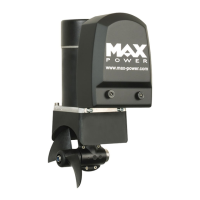Last update: February 2018
Apply a thin coating of silicon grease or sealing compound to both sides of the gasket
(this must be hydrocarbon and water resistant). Re-assemble all parts as before,
position and then tighten the two 6mm screws alternatively using a 5mm Allen key
(maximum torque: 12 Nm).
Check that the propeller rotate freely without resistance or friction.
It is imperative that the holes and the screws remain free of sealing compound,
otherwise there is a risk of an incorrect assembly of the parts.
Caution: do not use graphite grease.
NOTE:
The composite drive leg:
•
is pre-filled with oil and sealed for its lifetime circle
•
does not require anodes
•
must not be disassembled, even partially (terminates warranty)
4. ELECTRIC MOTOR (12 volts)
After having greased the motor’s shaft and the drive pin, place the motor on its
support. The motor should center itself and align easily when correctly mounted on its
support.
If not, drive leg, motor support and tunnel are incorrectly assembled. Most likely due to
an uneven surface on the outside radius of the GRP tunnel.
For the latter case, disassemble the motor support / drive leg assembly, sand the tunnel
so as to achieve a smooth exterior radius and repeat the previous steps.
Position the four 6 mm motor support screws, then tighten them alternatively
(maximum torque: 20 Nm).
5. PROPELLER
Insert the drive pin and propeller.
Check that the propeller turns without resistance (small resistance due to the motor is
normal).
Gradually tighten the 13 mm nut, while holding the propeller tightly with your hand
(maximum torque: 10 Nm).
Protect your hands during this operation to avoid risk of injuries caused by the edges of
propeller.
IMPORTANT: to avoid calcium deposits that could damage the seals, we
recommend that you coat the shaft and stainless steel cover with silicon grease.
6. PROTECTION GRILLS
It is possible to install protection grills; however installation of such grills will affect
thruster performance.
7. ELECTRICAL INSTALLATION
CAUTION: an incorrect electrical installation will cause rapid deterioration or even failure
of the thruster. Excessive voltage drop will cause premature wearing of the relays and
brushes. Special attention should be given to the quality, capacity and condition of your
batteries, as well as wiring sections that are used.

